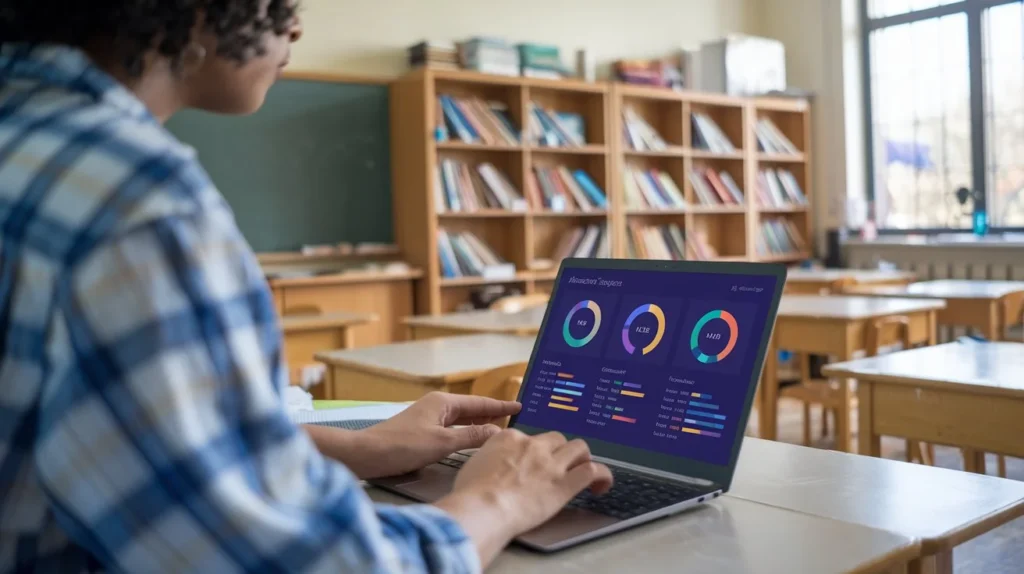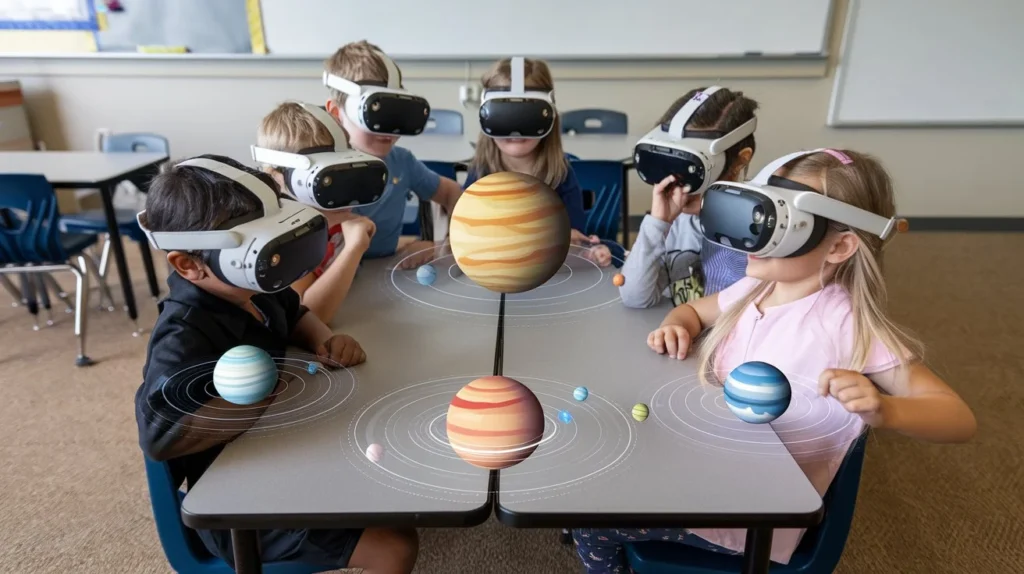Integrating Digital Learning in Childhood Education: A Comprehensive Approach
Table of Contents
Introduction
With the growing role of digital media in daily life, parents and educators face unique challenges and opportunities. Integrating interactive tools into children’s education promises enhanced engagement, improved cognitive development, and broader access to information. However, balancing the benefits of digital access with potential downsides, such as attention issues and over-reliance on screens, requires a carefully structured approach.
In this article, you’ll find insights grounded in cognitive and developmental research, along with practical strategies for using technology as an educational asset. This guide is designed to provide you with a well-rounded understanding of how to integrate digital learning effectively into a child’s developmental journey.
The Cognitive Impact of Digital Learning Tools
Studies indicate that technology, when integrated effectively, can stimulate cognitive growth and skill development in young learners.
1. Boosting Memory and Problem-Solving Skills
Interactive applications can enhance children’s ability to process, retain, and recall information. For example, a 2023 study published by the Journal of Educational Psychology found that children aged 5-10 who used math-oriented games performed 15% better in problem-solving tests than those who didn’t engage in such interactive activities. Through immediate feedback and gradual complexity, these tools provide a “scaffolded” learning approach that is known to enhance comprehension and retention.

2. Enhancing Creativity and Divergent Thinking
Digital drawing applications, story-building platforms, and puzzle games encourage children to think creatively. When children use these tools to design stories or solve complex puzzles, they engage in divergent thinking—a cognitive process that promotes creativity and flexibility. Studies from the American Academy of Pediatrics (2021) show that children exposed to creative software have higher scores in creative thinking assessments compared to their peers without such exposure.
3. Developing Language and Vocabulary Skills
Early exposure to language-learning apps and story-based interactive games has been shown to improve vocabulary acquisition in young children. Digital tools can introduce new vocabulary in context, making it easier for children to remember words and understand their meanings. For instance, a 2022 study by Frontiers in Psychology highlighted that children using interactive e-books had a 30% higher retention rate of new vocabulary than those reading non-interactive books.
Age-Appropriate Digital Learning: Structuring the Journey
Table: Recommended Digital Tools and Skills by Age
| Age Group | Developmental Focus | Recommended Tools |
|---|---|---|
| 2-4 years | Sensory & Motor Skills | Basic phonics apps, video storybooks |
| 5-7 years | Vocabulary & Early Math Skills | Story-based games, simple math puzzles |
| 8-10 years | Logical Reasoning & Creativity | Coding basics, digital drawing software |
| 11-12 years | Advanced Problem Solving & Research | Research platforms, language learning apps |
Guidance by Age:
- Toddlers (2-4 years): Interactive storybooks and phonics apps introduce new vocabulary and basic language skills.
- Primary Ages (5-7 years): Math and vocabulary games strengthen foundational knowledge and motor skills.
- Preteens (8-12 years): Coding apps and creative software enhance logical reasoning, critical thinking, and creativity.
Balancing Screen Time and Maintaining Engagement
Managing screen time is essential in leveraging digital learning effectively. Here’s what recent research suggests:
1. Structured Screen Time for Focus and Balance
The American Academy of Pediatrics suggests that children between the ages of 6 and 12 should have no more than two hours of screen time per day, particularly focusing on high-quality content. Screen time beyond recommended levels has been associated with reduced attention spans and behavioral issues. Implementing structured digital breaks can help mitigate screen fatigue and maintain children’s interest in learning.
2. Combining Digital with Hands-On Activities
Mixed-method learning that incorporates both screen-based and physical activities has proven more effective than digital-only approaches. For example, pairing a geography app with physical map exercises helps solidify spatial learning through multi-sensory engagement. According to research from Child Development Research (2022), children who engage in multi-sensory activities (like digital and physical puzzles) show a 20% improvement in long-term retention.
| Activity Type | Impact on Learning |
|---|---|
| Digital-only | Engages short-term memory, fast-paced feedback |
| Physical-only | Enhances sensory-motor skills, concentration |
| Mixed digital and physical | Improves long-term retention, multi-dimensional learning |
Emerging Technology in Education
As we look forward, several emerging technologies are transforming how students learn and interact with information.
1. Artificial Intelligence (AI) in Learning Support
AI-powered platforms can provide personalized feedback and adapt to individual student needs. Educational AI tools analyze performance data and adjust difficulty levels, creating customized learning pathways. This adaptability is particularly valuable in supporting diverse learning styles and pacing needs. Notably, AI-supported platforms like Smart Sparrow are being used in classrooms to improve comprehension by adapting tasks to each learner’s unique abilities.
2. Augmented Reality (AR) and Immersive Learning
AR tools offer experiential learning by overlaying digital information onto the real world. In subjects like history or biology, AR can transform abstract concepts into visual, interactive experiences. For instance, the Google Expeditions app allows students to take virtual “field trips” to historical sites, fostering deeper engagement with historical content.
| Technology | Description | Example |
|---|---|---|
| AI (Artificial Intelligence) | Tailored feedback, adaptive learning | Smart Sparrow, DreamBox Learning |
| AR (Augmented Reality) | Virtual real-world simulations | Google Expeditions, Merge Cube |
3. Gamified Learning Experiences
Gamification uses elements of game design in learning platforms to motivate children. Gamified applications, like Minecraft for Education, allow students to learn complex concepts (like architecture or ecosystem dynamics) in an interactive way. Research from EdTech Digest (2023) indicates that gamified environments improve student engagement by 40%, especially for students with attention-related challenges.

Best Practices for Integrating Digital Tools in Learning
- Set Clear Objectives: Define the purpose of each digital tool to ensure it aligns with educational goals. This approach keeps learning focused and reduces unnecessary screen time.
- Encourage Curiosity through Exploration: Offer your child diverse tools—like e-books, coding games, and art apps—to stimulate varied cognitive functions and maintain interest.
- Monitor Content Quality: Choose educational tools vetted for quality. Platforms that adhere to child-development research standards often deliver better learning outcomes.
- Balance Learning with Physical Activity: Incorporate physical activities to complement screen-based learning, which supports holistic development.
Frequently Asked Questions
1. How can I ensure the digital content is safe and effective for my child?
Look for applications that are age-appropriate, have high ratings for educational value, and are free from ads or unnecessary in-app purchases. Reading reviews on platforms like Common Sense Media can be helpful.
2. What types of digital tools are best for early cognitive development?
For young children, choose interactive storybooks and simple games that reinforce basic skills, such as phonics, numbers, and memory.
3. How do I encourage digital learning while preventing over-reliance on screens?
Set structured time limits and mix digital activities with hands-on, offline tasks. Use educational platforms to teach specific skills rather than for general screen time.
4. Can digital learning tools be beneficial for children with learning disabilities?
Yes, adaptive learning platforms are especially beneficial for children with learning disabilities as they provide personalized pathways that cater to individual learning needs.
Conclusion: A Balanced Approach to Digital Learning
Integrating technology thoughtfully into children’s education provides opportunities for enhanced learning, creativity, and skill development. By focusing on age-appropriate tools, setting clear boundaries, and combining digital learning with physical activities, you can create an enriching, balanced educational experience. With the rapid advancement of AI, AR, and gamification in education, the future of learning looks promising for young learners everywhere.
References
- American Psychological Association. (2022). The Effects of Technology on Child Development. APA.
- National Institutes of Health. (2021). Screen Time and Children’s Attention Spans. NIH.
- American Academy of Pediatrics. (2023). Screen Time Guidelines for Children. AAP.
- EdTech Digest. (2023). Gamified Learning Experiences in Education.
- Frontiers in Psychology. (2022). Vocabulary Retention in Young Children Using Interactive E-books.







